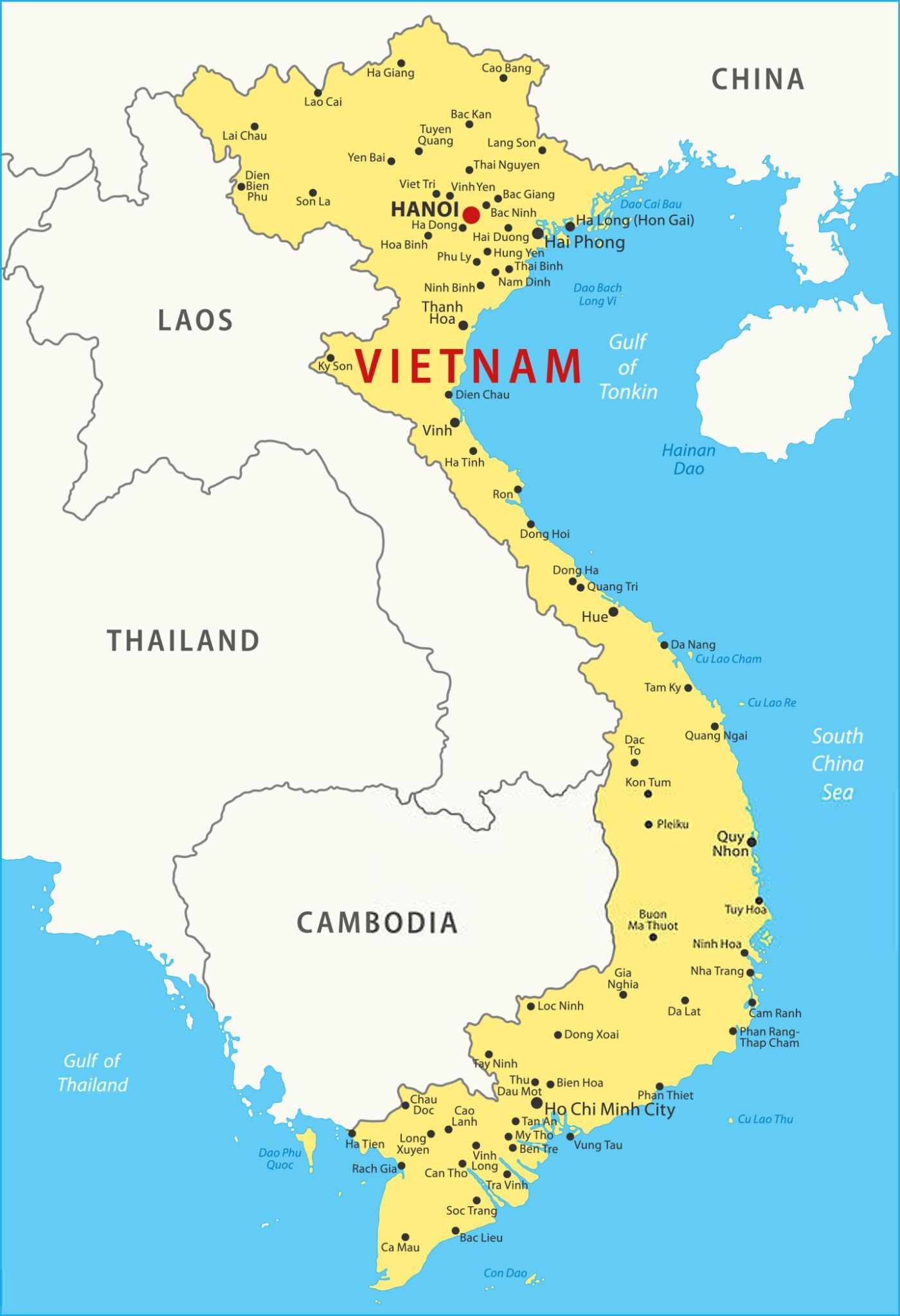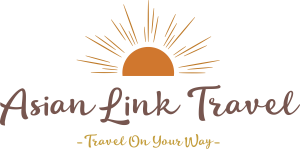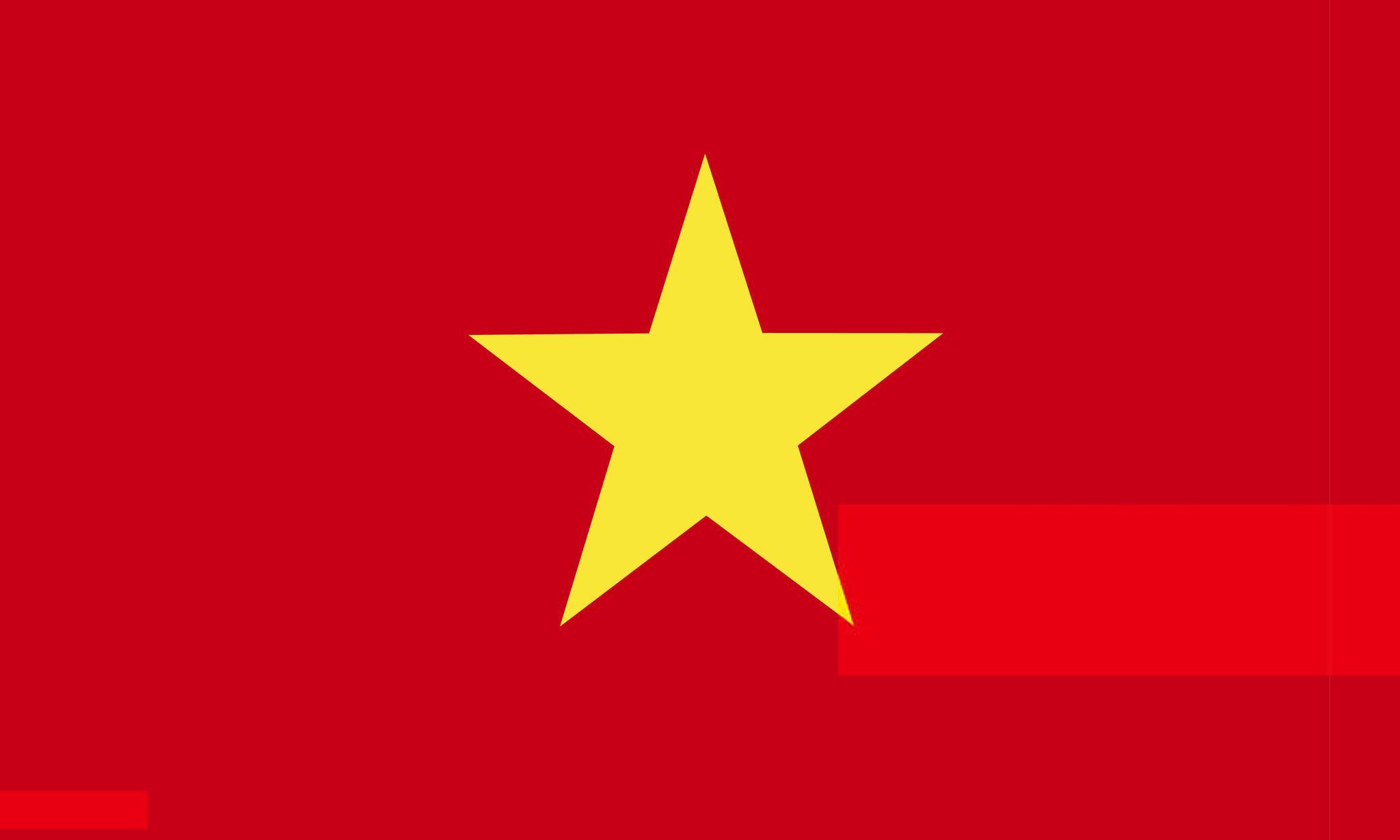Socialist Republic of Vietnam
 Population: 100,3 Millions
Population: 100,3 Millions
Area : 331,344.82 km²
Capital : Hanoi
Language : Vietnamese
Religion : Buddhism
Currency : Vietnamese Đồng (VND)
Time Zone : UTC+07:00
Vietnam is shaped like an “S” and stretches from north to south, with diverse landscapes across its 1,650 km (1,025 miles) length. It has three main regions:
Northern Vietnam (Red River Delta): This region is home to the capital, Hanoi, and the fertile Red River Delta. The northern region has mountainous terrain, including the Hoàng Liên Son range, where Vietnam’s highest peak, Fansipan, is located (3,147 meters).
Central Vietnam: This region includes both coastal plains and rugged mountains, with cities like Da Nang and Hue. The Central Highlands (Tây Nguyên) is known for coffee plantations and ethnic minorities. Central Vietnam experiences a tropical monsoon climate with a distinct rainy season from October to December.
Southern Vietnam (Mekong Delta): The southern part of Vietnam is dominated by the Mekong River Delta, a vast network of rivers, swamps, and islands. The city of Ho Chi Minh City (HCMC) is the economic powerhouse of the country. The south has a tropical climate with high humidity and a pronounced wet and dry season.
Climate: Vietnam experiences a tropical climate, which varies depending on the region.
Northern Vietnam experiences all four seasons, with hot summers and cool winters (sometimes cold enough to require jackets in the mountains).
Southern Vietnam has a more consistent tropical climate, with high temperatures year-round and a rainy season from May to November.
Central Vietnam sees significant rainfall, especially in the fall, due to typhoons and monsoons.
Politics and Government
Vietnam is officially a socialist republic, but its political system is unique in that it is a one-party state led by the Communist Party of Vietnam (CPV). The country is governed by:
The Party: The Communist Party holds all political power in Vietnam. The General Secretary of the Communist Party is the most powerful figure, effectively leading the country. The CPV maintains control over the government, military, and society.
The President: The President is the head of state and represents Vietnam in diplomatic matters, though their role is largely ceremonial compared to the power held by the Party General Secretary.
The Prime Minister: The Prime Minister is the head of government and is responsible for the country’s administration, economic policies, and day-to-day governance.
National Assembly: Vietnam’s unicameral legislature is made up of 500 representatives, elected every five years. However, the Communist Party has substantial influence over the selection process, and all candidates must align with the Party’s policies.
History and Conflicts
Vietnam’s history is marked by periods of foreign rule, war, and resistance:
Ancient and Medieval History: Vietnam was influenced by Chinese culture and was ruled by China for over 1,000 years (from 111 BCE to 938 CE). Despite this long period of occupation, Vietnamese people preserved their language, culture, and identity.
Colonial Era: In the mid-19th century, Vietnam became part of French Indochina. The French imposed economic exploitation, modern infrastructure, and an education system but also suppressed local culture and institutions.
War of Independence: After World War II, the First Indochina War (1946–1954) broke out between the French and the Viet Minh (led by communist revolutionary Ho Chi Minh). It ended with the Geneva Accords, which divided Vietnam at the 17th parallel, creating a communist North Vietnam and an anti-communist South Vietnam.
The Vietnam War: The Vietnam War (also known as the Second Indochina War, 1955–1975) was a major Cold War conflict between the communist North, supported by the Soviet Union and China, and the pro-Western South, supported by the United States. The war caused immense loss of life, including civilian casualties, and significant environmental damage. In 1975, North Vietnam succeeded in reunifying the country under communist control, and Saigon was renamed Ho Chi Minh City.
Post-War Era and Reform: After reunification, Vietnam faced significant economic hardship and isolation. However, in the 1980s, under the leadership of Đổi Mới (Renovation), Vietnam shifted from a command economy to a socialist-oriented market economy, opening up to foreign investment, improving trade relations, and fostering rapid economic growth.
Economy
Vietnam’s economy has undergone profound transformation in the past few decades, and today it is one of the fastest-growing economies in Asia:
Agriculture: Vietnam is one of the world’s leading producers of rice, coffee, and seafood (particularly shrimp and fish). Agriculture is still an important sector, although its share of GDP has been declining as the economy diversifies.
Manufacturing: The country has become a major manufacturing hub, especially for electronics, textiles, footwear, and furniture. Key international companies like Samsung, Intel, and Nike have set up factories in Vietnam due to its competitive labor costs and increasing integration into global supply chains.
Services: The service sector, including tourism, retail, banking, and technology, is growing rapidly. Vietnam’s expanding middle class has fueled demand for services and consumer goods.
Trade and Foreign Investment: Vietnam has become increasingly integrated into the global economy through free trade agreements, particularly with ASEAN, China, the European Union, and the United States. It is a key part of the Comprehensive and Progressive Agreement for Trans-Pacific Partnership (CPTPP).
Challenges: Despite rapid growth, Vietnam faces challenges such as corruption, inequality between urban and rural areas, environmental degradation, and an overreliance on foreign direct investment (FDI) and exports.
Culture and Society
Vietnamese culture is a unique blend of indigenous traditions and influences from neighboring countries and historical interactions with colonizing powers. Some key aspects include:
Language: Vietnamese is the official language and is spoken by the vast majority of the population. It is a tonal language with six tones, and the Latin alphabet, which replaced the traditional Chữ Nôm script, is used for writing.
Cuisine: Vietnamese cuisine is known for its balance of flavors—sweet, salty, sour, and bitter—and emphasis on fresh ingredients. Some famous dishes include:
-
- Pho (a noodle soup)
- Banh Mi (Vietnamese sandwich)
- Goi Cuon (spring rolls)
- Com tam (broken rice with grilled pork)
- Bánh Xèo (Vietnamese pancakes)
- Festivals: The most important holiday in Vietnam is Tết Nguyên Đán (Lunar New Year), which celebrates the arrival of spring. It is a time for family reunions, honoring ancestors, and paying respects to deities.
- Art and Literature: Vietnamese art and literature often reflect themes of patriotism, nature, and Buddhist philosophy. Traditional arts include water puppetry, calligraphy, and lacquer painting. The hát quan họ (traditional folk singing) and ca trù are also significant cultural expressions.
- Ethnic Diversity: While the Kinh (Viet) ethnic group comprises around 85-90% of the population, there are over 50 ethnic minorities in Vietnam, including the Tay, H’mong, Khmer, and Cham. These groups contribute to the country’s rich cultural diversity.
Environmental Issues
Vietnam faces several pressing environmental challenges:
Air and Water Pollution: Rapid urbanization, industrial growth, and motor vehicle use have led to poor air quality in cities like Hanoi and Ho Chi Minh City. Water pollution, particularly in the Mekong Delta, is a growing concern due to agricultural runoff and waste.
Climate Change and Rising Sea Levels: The Mekong Delta is particularly vulnerable to the impacts of climate change, including rising sea levels and saltwater intrusion, which threatens rice production and livelihoods.
Deforestation: Although Vietnam has made progress in reforesting certain areas, deforestation and illegal logging remain issues, threatening biodiversity and forest-dependent communities.
Sustainability Efforts: Vietnam is increasingly focused on sustainable development, particularly in the areas of renewable energy, waste management, and conservation.
Education and Healthcare
Education: Vietnam has made significant strides in education, with a high literacy rate (nearly 95%). The country has placed a strong emphasis on primary and secondary education, and university enrollment is increasing. However, there are concerns about the quality of higher education and the disparity between urban and rural access to education.
Healthcare: Vietnam’s healthcare system has improved markedly since the 1990s, with life expectancy rising and infant mortality rates falling. However, there are challenges related to access to healthcare in rural areas, and the healthcare system is under strain due to an aging population and increasing demand for services.
Tourism
Vietnam is a growing tourist destination, attracting millions of visitors each year. Major tourist attractions include:
Ha Long Bay: A UNESCO World Heritage site famous for its emerald waters and limestone karsts.
Hội An: An ancient town known for its well-preserved historic architecture, lantern-lit streets, and vibrant arts scene.
Phong Nha-Kẻ Bàng National


 Show all photos
Show all photos 
